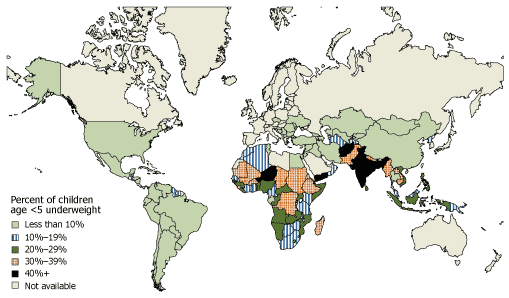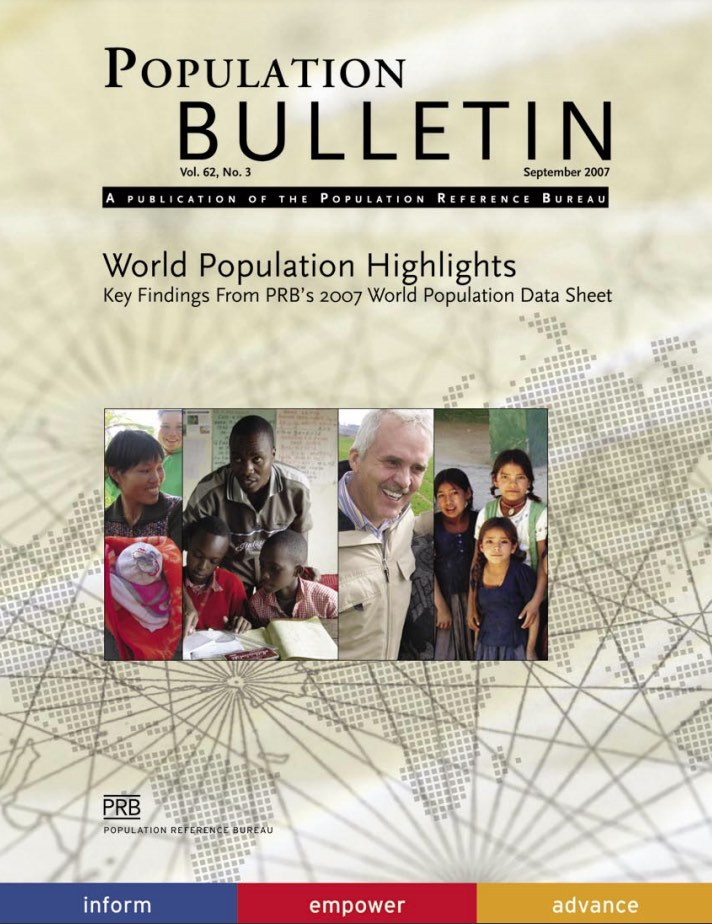
World Population Highlights 2007: Malnutrition
Date
August 16, 2007
Author
Focus Area
(September 2007) Malnutrition is an underlying cause of disease and death in poor countries. In fact, about 56 percent of child deaths are associated with malnutrition.
Expectant mothers who are malnourished are more likely to have low birth-weight babies. Malnourished infants and children suffer from stunted physical and mental development. Malnutrition also reduces productivity. Children who are undernourished, for example, enroll in school later, are absent more often, and complete fewer years of schooling than well-nourished children.
Despite important progress in reducing stunting and underweight in some regions, about 30 percent of all children in low- and middle-income countries are underweight. In addition, the rate of stunting (low height for age) in some places, such as parts of India, is between 50 percent and 60 percent. Moreover, more than 2 billion people worldwide suffer from deficiencies in micronutrients (key vitamins and minerals). Thirty-seven percent of the world’s population suffers from anemia and 35 percent are at risk of iodine deficiency. About 25 percent of preschool-age children suffer from vitamin A deficiency. At the same time, many experts believe there is an “epidemic of obesity,” with as many as one-third of men or women obese in some countries.
In Low-Income and Middle-Income Countries, 30 Percent of All Children Are Underweight.

Source: Carl Haub, 2007 World Population Data Sheet.
What Causes Malnutrition?
The immediate causes of undernutrition are insufficient intake of food, and disease that makes it difficult to eat or to absorb food. However, underlying causes of undernutrition include a lack of income to buy food; inadequate access to food; a lack of access to health services; an unhealthy environment and poor hygiene; and poor eating habits. The risk of undernutrition is also especially high during fetal development and until about two years of age. Much of the damage undernutrition causes to physical and mental development during this period cannot be reversed.
Cost-Effective Interventions
In the short run, countries should incorporate growth monitoring and promotion, behavior change communication, and salt iodization in their health programs. In the medium term, they can establish community-based nutrition programs that target young children, adolescent girls, and pregnant women. They can also operate safety net programs, such as food stamp programs or cash transfer programs, that focus on improving nutrition. In addition, they can take steps to fortify widely consumed products, such as flour or cooking oil, with needed micronutrients. Countries that face problems of overweight and obesity can introduce diet and exercise-related motivational programs in schools, communities, and workplaces; improve the quality of school meals; and enhance food labeling.
Case In Point.
The Indian states of Bihar and Jharkhand are among the poorest in India and have high rates of malnutrition. While clearly a manifestation of poverty, malnutrition is also associated with some traditional cultural practices. A UNICEF-assisted program, Dular (“to care and love”), focuses on improving the nutrition of young children and pregnant women through behavior change. Food should be introduced, in addition to breastfeeding, when a child is six months old. Finding that the introduction of these foods awaited a Hindu ceremony occurring at 12 months, Dular staff worked with religious leaders and were often successful in having the ceremonies moved up to six months.
Sources
Harold Alderman et al., “Nutrition, Malnutrition, and Economic Growth,” in Health and Economic Growth: Findings and Policy Implications, ed. Berta Rivera Lopez-Casasnovas and Luis Currais (Cambridge, MA: MIT Press, 2005).
Laura E. Caulfield et al., “Undernutrition as an Underlying Cause of Child Deaths Associated With Diarrhea, Pneumonia, Malaria, and Measles,” American Journal of Clinical Nutrition 80, no. 1 (2004): 193-98.
Carl Haub, 2007 World Population Data Sheet (Washington, DC: Population Reference Bureau, 2007).
F. James Levinson and Lucy Bassett, Malnutrition Is the Leading Killer of Young Children (Washington, DC: Population Reference Bureau, 2007).
David L. Pelletier and Edward A. Frongillo, “Changes in Child Survival Are Strongly Associated With Changes in Malnutrition in Developing Countries,” Journal of Nutrition 133, no. 1 (2003): 107-19.

 ">
">